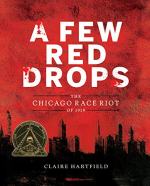|
This section contains 545 words (approx. 2 pages at 400 words per page) |

|
A Few Red Drops Summary & Study Guide Description
A Few Red Drops Summary & Study Guide includes comprehensive information and analysis to help you understand the book. This study guide contains the following sections:
This detailed literature summary also contains Quotes and a Free Quiz on A Few Red Drops by Claire Hartfield.
The following version of this book was used to create this study guide: Hartfield, Claire. A Few Red Drops. Clarion Books, 2018.
A Few Red Drops by Claire Hartfield is a non-fiction, historical account of the Chicago race riots of 1919. It is divided into four broad parts, with the first containing two chapters, the second containing six chapters, the third containing six chapters, and the fourth containing six chapters as well. This guide is divided into five sections, with the first three addressing the first three parts of the book, respectively, and the last two addressing the final part of the book.
“The Beach” and “A Time to Reap” introduce the events of July 27th, 1919, when the race riots began. John Turner Harris and his friends, the Williams boys, were swimming at the beach when one of their friends was killed by a rock thrown by a white man who resented how close they were getting to the unofficially ‘white’ part of the beach. The ensuing anger felt by black crowds at the beach sparked the riots which followed.
“Freedom Fight,” “Self-Reliance,” “White Negroes,” “Waste Matters,” and “Parallel Universes” collectively explain the history of Chicago’s black residents and the kinds of work they had in the city. The Union Stock Yard and its political dynamics was key to the employment of blacks and that of white immigrant communities, which Hartfield explains created racial tension in the poorer parts of the city. Unionists and their desire to mobilize both black and white workers would play a significant role in attempting to downplay the racial tension.
“A Higher Call,” “Northern Fever,” “A Real Place for Negroes,” “A Job, Any Job,” “Full to Bursting,” and “Respectability and Respect” outline the migration of black workers from the South to the North, tracing several of Chicago’s urban problems to this occurrence. The shortage of housing, heightened black visibility and racial tension, and other social and economic issues which inspired white hatred towards blacks in the early 1900s all stem from this great movement of people who sought a better life.
“Tension Rising,” “Last Straws,” and “Race Riots,” detail the eruption of violence between blacks and whites following the murder of Eugene Williams in July 1919. Both communities, having silently harbored prejudices and anger towards one another, found each other to blame for the incident, and mob violence and gang aggression ensued. Political incompetence at the municipal level was made worse by the inaccessibility of the black and immigrant neighborhoods in urban Chicago.
“Ratcheting Up,” “Point-Counterpoint,” “Moment of Truth,” and “Epilogue” trace the continuation of violence and its eventual cessation, as the high tide of emotions receded and the damage was calculated. Hartfield emphasizes the inequality in Chicago’s administering of justice following the riots, as two-thirds of the victims of violence had been black while only one-third of the perpetrators found to be guilty were white. “Epilogue” in particular provides room for Hartfield to expand upon the lessons of the Chicago race riots, which she sees as necessary in today’s similarly tumultuous period in America. Citing the civil rights movement alongside these events of 1919, Hartfield sees ample strength in black communities as well as stark inequalities which hold ‘Black America’ back, according to the author.
Read more from the Study Guide
|
This section contains 545 words (approx. 2 pages at 400 words per page) |

|



